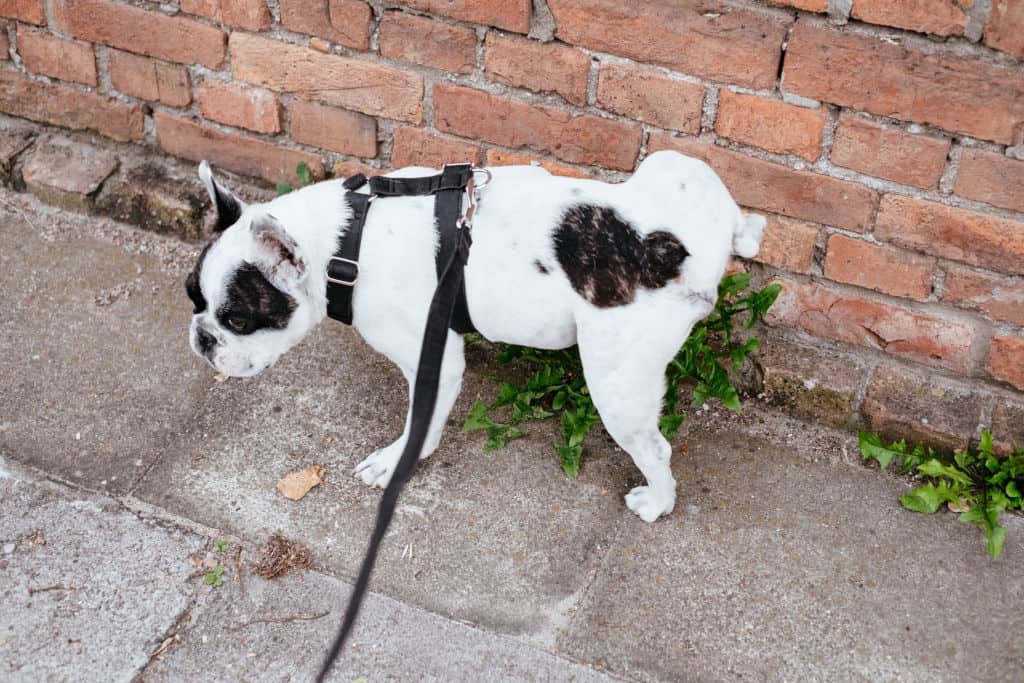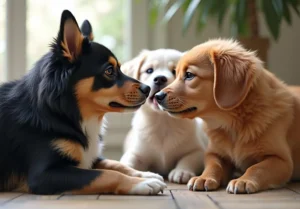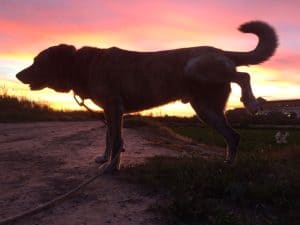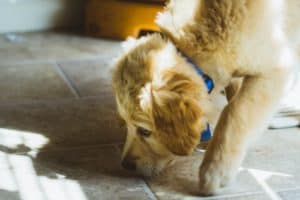Disclosure: We may earn a commission from helpful, relevant links in our content. No cost to you. See our privacy policy.
Dogs like to pee on many things and places, but for some reason, plastic bags can seem very attractive to a dog. Why is that?
Plastic frequently contains compounds that attract dogs, such as ammonia, one of the substances in the urine. Ammonia smells like pee, so dogs are attracted to it. In addition, dogs like crinkling sounds when peeing on things, which peeing on plastic produces.
This article explores why dogs pee on things and how to train them in this behavior.

Why Some Dogs Pee on Plastic?
One of the main causes why dogs pee on plastic is because we use ammonia to produce plastics, and dogs are attracted to it. Ammonia smells a bit like urine, so dogs will sometimes pee on it. Dogs also enjoy crinkle sounds so much that they might decide to pee on them to claim them as their own.
Environmental factors also play a role in a dog’s behavior. If a plastic bag has come in contact with food or other organic material, it might contain lingering scents that pique a dog’s curiosity, leading them to mark the bag.
It’s worth noting that not all plastics contain ammonia or give off an ammonia-like scent. The reaction of a dog to a plastic bag might vary based on its manufacturing and the specific compounds present.
Many dog toys, such as plush toys with empty water bottles inside, generate crinkle sounds, so dogs will like to play with them.
However, avoid leaving a plastic bag on the floor. I realized no throw rug was safe when I got my first rescued dog. She would pee on them when she was nervous, sometimes just a little bit. I had to train my puppy not to pee on rugs.
Why Do Dogs Pee on Things in General?
Dogs communicate a lot about themselves to other dogs through the aroma of their urine. It is also part of their psychological requirements. Dogs do not seek to cover up their scent because they use the locations they pee on to communicate with other dogs.
Canines may send other information through urine, such as availability for mating and the identification of the “marker” to other dogs in the group. Still, rivalry or a challenge may also be signaled by leaving more than the typical amount of marks around certain areas.
They are far pickier than people regarding their favorite areas. One thing they’re saying is that they’re marking their territory.
Because dogs are descended from wolves, they mark the boundaries of their territory. Wolves usually do this to reduce the number of predators in a specific region so that they have enough food to feed the group. If another predator hunts in your area, your group may be forced to migrate or starve.
Therefore, you keep other predators away from your hunting grounds. To warn them that they are intruding, you mark your area – just as humanity put up fences, wolves and, consequently, dogs spray their pee along the borders of their territory.
Dogs may also pee as a result of separation anxiety. A house-trained dog does not pee on the carpet because his owner is gone. Instead, he pees himself out of sheer panic.
In response to a perceived threat, some puppies urinate submissively. This is a valuable survival technique in the dog pack since it efficiently avoids the anger of most adult dogs that would otherwise cause serious injury to a young subordinate.
Unfortunately, when the higher-ranking member is a human, the behavior that should avert rage frequently causes or accelerates wrath in the human. The pup responds by urinating more, not less.
How Do You Keep Dogs From Peeing on Things?
First, ensure that the soiled regions have been cleaned with an enzyme cleaner. Otherwise, your dogs will continue to pee there. Continue to praise them when they go in the correct places, and only warn them to stop if they are in the act/sniffing around the area as if they are about to pee.
If you house-train your dog using punishment, it may take a long time to penalize him in every location where he is not meant to urinate. It is easier and faster to teach him obedience and what you want him to do through positive reinforcement.
When you yell or punish a dog after peeing, you may believe you have just taught him not to pee in the home. But you truly taught him not to pee in front of you. He’ll go to the rear bedroom to pee the next time.
Punishing a puppy for peeing in the house will cause the puppy to lose faith in you and sneak away to urinate while you’re not looking. Similarly, praising the dog while urinating in the house may lead the dog to believe that peeing in the house is desirable.
Try staying ahead of the dog’s potty schedule by taking the dog out more frequently. If the dog has an accident, you can interrupt them and lead them outdoors to potty. Clean up the mess with an enzymatic cleanser to prevent the smell from attracting it to the exact location again. [Full guide on potty training]
You can try training your dog to pee on command. Take your puppy outside if they exhibit signs of needing to pee (they usually begin by smelling the ground, then circle or squat). Say your vocal cue as soon as they start peeing. When you give your pup the verbal cue, praise them and have a treat ready for when they finish and come to you.
The dog will eventually associate your vocal cue with the use of the restroom. Then, as soon as they step outside, give the verbal cue, and they should do it on command. If you’re still having trouble, look into getting some potty training aids to help you out.

Some sprays are available to urge your pups to mark elsewhere. However, I don’t know how successfully the spray will discourage the activity. Another option is to put them on a leash and direct them to a specific place when they go potty. They get a treat and can go off-leash after that.
If you don’t wish your dog to pee in some regions of the house, you can use baby gates to keep him near you and prevent him from wandering into another room to poop, pee, or chew.
You may also use the puppy potty pads. People frequently train small dogs to use pee pads as a permanent solution for potty training, especially in apartments or metropolitan areas where frequent outside walks are impossible. If the potty pads work and you’ve gained your dog’s trust, you can use them both inside and outside, but just outside at first.
Consider obtaining a pet potty leak-proof pad. It consists of a shallow plastic tray with an astroturf insert. An artificial grass rug pad that is simple to clean with a hose and a little dish soap.
Astroturf, while often used for indoor dog areas, can sometimes be mistaken by dogs as a marking spot due to its similarity to grass. This can be handy for potty training, but make sure to clean it regularly to avoid any lingering odors.
If your dog pees, you must clean it up. Use an enzymatic cleaner to soak the carpet or wipe down the floor, so your puppy doesn’t think the area smells like pee or poop. Petastic and Anti-Icky Poo are two examples of excellent products.
What Kind of Surface Do Dogs Prefer to Pee On?
Dogs prefer to pee on whatever they get used to in their daily habits. Your dog might pick grass, concrete, or dirt. When trained, puppies may develop a surface preference that lasts into adulthood.
Textures play a role in a dog’s decision to pee. Dogs often prefer softer surfaces that can absorb their urine, which might explain why a discarded item of clothing or a plush toy occasionally becomes a target.
Some pads contain attractants that mimic the smells of grass, ammonia, and pheromones. While this may be effective for some dogs, others may play or sleep on the pad.
Dogs also like to urinate on high surfaces. They’re leaving scent messages for any other canines who follow them. Urinating on vertical objects makes the aroma stand out and aids airborne pickup and transmission.
Dogs have incredible olfactory senses, which means even if we can’t smell traces of urine, they can. Regularly cleaning areas where your dog frequently spends time can deter them from marking those spaces, ensuring they’re not enticed by old scents.
FAQs
Why do cats pee on plastic bags?
Plastic frequently contains compounds that imitate hormones and pheromones, which explains why cats prefer trash like plastic bags. However, plastic bags should not be accessible to your cat. It would be best to store them away because they pose a choking hazard.
How often do dogs need to pee?
Dogs usually urinate three to five times per day, depending on the breed, amount of water consumed, degree of activity, etc. Dogs shouldn’t go for more than 8 hours without going to the bathroom.
What causes my dog to pee on my clothes?
Dogs’ noses are more sensitive, and varied surfaces comfort and frighten them. It’s possible that peeing on your clothes has become a habit. Your best hope for correcting this tendency is to startle your dog while he’s peeing with a vocal interrupter. If a dog pees in the same spot again, his delicate nose will pick up the smell and repeat the process.
What smell can mask dog urine?
Traditional cleaning supplies include vinegar, baking soda, and soap. You can combine a cup of peroxide, three tablespoons of baking soda, and a some dish detergent. Spray the affected area, let it stay for about 20 minutes, and then rub it until the stink is gone.
Products that can clean the smell of dog urine and poop include Nature’s Miracle and Petastic, which have always been quite effective for me.
Alex, a passionate animal lover, has experience in training and understanding animal behavior. As a proud pet parent to two dogs and three cats, he founded AnimalReport.net to share insights from animal experts and expand his knowledge of the animal kingdom.




